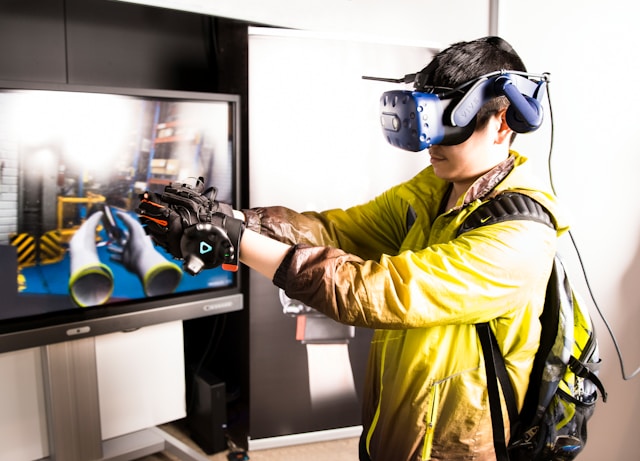What Is Augmented Reality?
Augmented reality (AR) marks pivotal shift in how digital content intersects with our daily lives. This innovative technology overlays digital information—such as images, data, and animations—directly onto our view of the real world, blending digital creations with physical environments. AR has the power to transform industries, from gaming and retail to real estate and beyond, by turning ordinary settings into extraordinary interactive experiences. Through smartphones or AR headsets, users witness a new dimension of reality, enriched by virtual elements coexisting with their physical surroundings.
Revolutionizing Entertainment: AR in Video Games

AR games introduce a novel genre in the gaming world, bringing unparalleled interactivity and immersion. Unlike traditional video games confined to screens, AR games invite the physical world into play, allowing digital and physical realms to merge seamlessly. This interactivity is not just innovative; it elevates the gaming experience to unprecedented levels, resembling scenes from science fiction.
Examples and Innovations in Gaming Technology
GPS-Based Gaming
One of the most exciting innovations in gaming is the integration of GPS technology, which allows players to interact with the real world through their devices. Games like Pokémon Go and Jurassic Park World leverage real-time GPS data to transform local neighborhoods into expansive game maps.
In these games, players must physically explore their surroundings to find and capture virtual creatures or complete missions. For example, in Pokémon Go, players go outside to locate Pokémon that appear on their screens as they move through parks, streets, and other locations. This blending of real and virtual worlds encourages physical activity and exploration, creating a unique gaming experience that extends beyond traditional screen-based play.
Holographic Technology
Another groundbreaking innovation in the gaming industry is the use of holographic technology, particularly in augmented reality (AR) gaming. This technology allows digital objects and characters to be projected into the player’s real environment, significantly enhancing immersion.
For instance, AR games can display lifelike holograms of characters that interact with the player’s physical space. Players might see a dragon perched on their living room table or a character that appears to walk alongside them in a park. This immersive experience is far beyond what traditional gaming offers, as it engages players in a way that feels more tangible and real.
Holographic technology not only enhances gameplay but also opens up new possibilities for storytelling and interaction within games. By merging digital elements with the physical world, players can have richer, more engaging experiences that deepen their connection to the game.
The State of AR Gaming in 2024
The AR gaming industry has witnessed tremendous growth, evolving from prototypes to blockbuster titles. Thanks to advancements from tech giants like Google, Apple, and Microsoft, alongside developer tools like ARCore, ARKit, and Unity’s AR Foundation, the domain of AR gaming has expanded significantly. The result? A diverse landscape of games that cater to various interests and activities, from epic quests to puzzle-solving adventures, all taking place in the blend of virtual and real worlds.
Technological Foundations of Augmented Reality in Gaming
Fiducial Marker Technology
Fiducial marker technology plays a crucial role in augmented reality (AR) gaming by acting as digital anchors. These markers are recognizable patterns or images that mobile devices can identify using their cameras. When a device detects a fiducial marker in the real world, it triggers specific AR experiences related to that marker.
For example, in a game, a player might point their device at a printed image or a specific location, and the game responds by overlaying digital elements—such as characters or animations—onto that marker. This interaction allows for an engaging blend of the virtual and real worlds, making the gameplay more interactive and immersive.
Simultaneous Localization and Mapping (SLAM)
Simultaneous Localization and Mapping (SLAM) is a more advanced technology used in AR gaming. It involves the use of device sensors to map the surrounding environment in real-time while simultaneously determining the user’s location within that space.
SLAM allows for a seamless integration of digital elements into the real world by continuously updating the game’s understanding of the environment. For instance, if a player moves through a room, SLAM technology ensures that virtual objects maintain their position relative to real-world objects, providing a coherent and immersive experience. This capability makes AR interactions more fluid and realistic, allowing players to engage with digital content as if it were physically present in their surroundings.
Spatial Computing
The future of AR gaming is heavily leaning towards spatial computing, which involves using specialized AR headsets or glasses. Unlike mobile devices that rely on cameras and screens, spatial computing aims to create a more integrated and immersive experience by directly merging digital elements with the physical environment.
AR headsets can track the user’s movements and the spatial relationships between objects in real time, allowing for more complex interactions. For example, a player could physically walk around virtual characters or objects, interact with them from different angles, and experience a sense of presence that traditional gaming setups cannot offer.
As spatial computing technology advances, it promises to enhance AR gaming by making experiences more interactive, intuitive, and engaging. This evolution could redefine how players interact with games, fostering deeper connections between the digital and physical worlds.
Trailblazing AR Games

The landscape of AR gaming is diverse, with numerous games offering a variety of experiences that leverage the real world to enhance gameplay. From battling mythical creatures in your backyard to uncovering treasure around your city, AR games provide a unique blend of physical activity and digital entertainment.
AR vs. VR: What’s the Difference?
While both augmented reality and virtual reality (VR) offer immersive experiences, they cater to different desires. AR enhances your real-world environment with virtual elements, whereas VR transports you to a fully digital universe. The choice between AR and VR depends on the level of immersion and interaction with the physical world you seek.
Is AR the Future?
Absolutely. AR’s capacity to merge digital content with the real world opens up vast possibilities for not only gaming but also education, healthcare, and retail. As technology progresses, AR will offer increasingly rich and immersive experiences, signaling a bright future for AR in various domains.
Why Embrace AR?
Augmented reality offers boundless opportunities for enhancement in daily life and entertainment. Whether for fun, learning, or improving productivity, AR technology holds promises of innovation and exploration, changing how we interact with the world around us.
Conclusion: The Unbounded Potential of AR Gaming
Augmented reality gaming stands at the precipice of transforming entertainment, offering a glimpse into a future where the boundaries between the digital and physical worlds are increasingly blurred. As technology evolves, we can anticipate a new era of gaming that further integrates our virtual and physical experiences, heralding an exciting chapter for gamers and tech enthusiasts alike.












